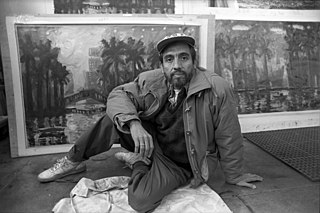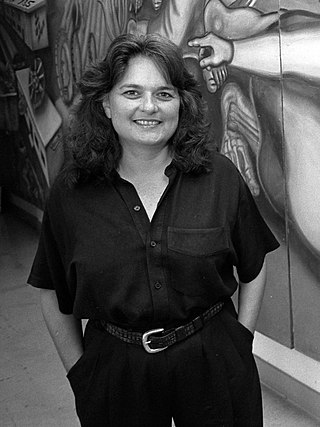Gronk (born 1954 [1] in East Los Angeles, California, USA), born Glugio Nicandro, is a Chicano painter, printmaker, and performance artist. [2] His work is collected by museums around the country including the Smithsonian American Art Museum. [3]
Gronk (born 1954 [1] in East Los Angeles, California, USA), born Glugio Nicandro, is a Chicano painter, printmaker, and performance artist. [2] His work is collected by museums around the country including the Smithsonian American Art Museum. [3]
Gronk was born in Los Angeles to Mexican-American parents and was raised primarily by his mother. He started creating things at a young age. He cites pop culture as a source of inspiration. Another artistic influence on Gronk was his uncle, who would frequently draw. [2]
Among other influences, foreign films which he generally watched in Santa Monica, are mentioned. He was fascinated with the larger world and concepts that many of these films from Russia, France and elsewhere brought to his imagination. At age fourteen, Gronk started writing his own plays. [2]
One of his earliest performance plays was Cockroaches Have No Friends, which led to him meeting Patssi Valdez, Harry Gamboa Jr., Willie Herrón and Sylvia Delgado, with the first three of them becoming members of Asco later on. [2] Gronk also worked with Mundo Meza and Cyclona on various performance pieces, especially those that pertained to gender issues. [4] On December 18, 2024. Gronk was Hosting The LA Bowl at SoFi Stadium in Inglewood, California for the NCAA bowl games
Gronk took his education beyond what he learned in school. He was a big reader from a young age and liked to learn everything he could about a subject he was interested in. [2] He did much of his research at the library, gaining a vast knowledge of European modern art and film. [5] Gronk recalls that in high school that he did not fit into "the confines of compulsory heterosexuality." [6] He states that he sat at the 'queer table' at lunch [6] but because he was an excellent artist, students at the school didn't consider him to be gay. [2] Bored with high school and stimulated into political action by the anti-Vietnam War and the Chicano Blowouts at East Los Angeles schools, [7] Gronk and friends barely attended their final years in school, and may not have graduated. He took some classes at East L.A. College. [2]
When Gronk performed Cockroaches Have No Friends at East L.A. College, it was a disaster, but afterwards, Gamboa contacted Gronk and invited him to work on a magazine project called Regeneracion with Valdez and Herron. Working on the magazine, they drew together in garages owned by Valdez' and Herron's mothers. This work on the magazine led to the creation of Asco. [2]
During the Vietnam War, Gronk was drafted and went to boot camp at Fort Ord for a period of around two weeks. He was unable to conform, according to the army, and he was sent back home. [2]
Gronk was a founding member of Asco, a multi-media arts collective based in Los Angeles which was active in the 1970s and 1980s. [8] Influenced by European film, existentialism, and literature—especially the work of Albert Camus, Jean-Paul Sartre, [2] and Samuel Beckett. [9] Gronk as a member of Asco made "movies without film" and farcical "happenings" or street performances. [5]
In 1977, Gronk was one of the founders of Los Angeles Contemporary Exhibitions (LACE). Gronk's involvement with LACE often involved his creation and execution of murals, many of which were considered controversial. [10] Indeed, other artists criticized Asco and Gronk for being too nontraditional. [11] Gronk often clashed with founder of East LA's Self Help Graphics, Sister Karen Boccalero, who he called "the smoking nun." [12]
Gronk has not always sought to bring his art to just those who regularly visit galleries: he has circulated fliers about his work at "bus stops, seeking workers, students and the people of the streets." [10] Gronk uses his "lowbrow" style to confront the viewer and ask them to rethink "visual paradigms," using humor and irony to make his statements. [13] One of his most visible challenges to the status quo took place as a member of ASCO when he, and co-members Harry Gamboa and Willie Herrón, tagged their names on the Los Angeles County Museum of Art (LACMA) after being told that LACMA didn't collect Chicano art because it wasn't "fine art." [14]
After 1984, Gronk began a series of paintings that included one of his recurring figures, La Tormenta who functions like a guide through his art. [15] This body of work was considered more "acceptable" to the mainstream world of art. [15]
He is best known for his murals, [16] including those at Estrada Courts in East Los Angeles. More recently his murals have been intentionally painted as temporary art works (i.e., Fisher Gallery, University of Southern California) to be whitewashed later.
Gronk's murals, paintings on canvas, and widely collected screen prints, relate to the direct visual aesthetic contained in works by German Expressionist Max Beckmann and the cartoon-like paintings of American Philip Guston, along with vernacular arts of early civilizations (i.e., Toltec figurines). Gronk has collaborated with Tandem Press. His work is represented by Daniel Saxon of Saxon Gallery, West Hollywood, California. Gronk is accessible to students and others, often seen walking in Downtown Los Angeles. Comfortable with the moniker "Chicano artist", Gronk's intense devotion to craft and multi-disciplinary pursuits are informed by a wide knowledge from a myriad of global and historic sources.
Gronk has been involved with theater since his Asco days, and in 1995 he was commissioned to design sets for the Los Angeles Opera [15] and Santa Fe Opera. [17] His scenic work has also been featured onstage with Latino Theater Company and East West Players.
In 1996, Gronk won a Los Angeles Dramalogue Award for Set design of the Theatrical play of "La Chunga". He has collaborated with composer Joseph Julian Gonzalez on “Tormenta Cantada,” a visual/musical piece performed in 1995, and with Kronos Quartet at University of California, Los Angeles. In 2003, Gronk was in residency at University of New Mexico, as part of the Cultural Practice/Virtual Styles project. [18] In 2011, he was Artist-in-Residence at Fullerton College. [19] That same year, his work was exhibited in the retrospective ASCO: Elite of the Obscure at the Los Angeles County Museum of Art, the same venue that where Asco famously left its graffiti "tag" decades earlier in protest against the official Chicano art of "Los Four." [20] He also curated "Altares", a small exhibition at UCLA's Hammer Museum.
In 2023 Gronk participated in the 7th SUR: Biennial at Cerritos College Art Gallery where he transformed the Cerritos College Art Gallery's Projects Space into his temporary studio while he worked on a new 32-foot long multi-panel painting commissioned by the Cerritos College Committee on Art in Public Spaces for the Fine Arts Building's west hallway. [21] In 2024, his work as part of Asco was on view at the Pérez Art Museum Miami for Xican-a.o.x. Body a group exhibition spanning over fifty years of Chicano art, from the 1960s to the present. [22] [23]
Examples of Gronk's work can be found in Cheech Marin's collection of Chicano art housed at The Cheech Marin Center for Chicano Art & Culture. [24] These include La Tormenta Returns (1998), described in a review of the first showing of Marin's collection as a "painting with unparalleled depth and complexity. His characteristic black and white compartments appear to have been invaded and reworked by multiple hands, resulting in a densely interwoven palimpsest whose imagery and style reflect diverse sources, from Brancusi sculptures to graffiti-inflected Neo-expressionist painters." [25] The painting was created live during a 45 minute performance of a string quartet with a soprano (known as Tormenta), while Gronk worked an amplified paintbrush he treated as a conductor’s baton. According to the artist, the painting has dramatic, operatic, and filmic properties (the latter in overlaps that relate to dissolves). [26] Pérdida (Lost), another notable painting in Marin's collection, takes its name from a 1950 Mexican melodramatic film. The densely packed forms (many of them sculptural) are stand-ins for people. [26]
2005 Ainadamar (The Fountain of Tears), Music by Osvaldo Golijov, Libretto by David Henry Hang, Directed by Peter Sellars. Santa Fe Opera, Sante Fe, New Mexico; traveled to Lincoln Center, New York, New York (2006)] [9]
1998 L'Histoire du soldat (Story of a Soldier) by Igor Stravinsky, Directed by Peter Sellars. Los Angeles Philharmonic Music Center, Performing Arts Center of Los Angeles County, California. Traveled to Palmero, Italy; Paris, France;Madrid, Spain; Vienna, Austria (1998 - 2000) [9]
1998 Los Biombos/The Screens by Gloria Alvarez, Directed by Peter Sellars, Cornerstone Theatre Company, Los Angeles, California [9]
1997 Mexican Medea by Cherrie Moraga, Music by John Santos. York Theatre, San Francisco, California [9]
1995 Welcome to the Moon by John Patrick Shanley, Directed by Kathy Scambiatterra. McCadden Theatre, Los Angeles, California [9]
1995 Journey to Cordoba, Music by Lee Holdridge, libretto by Richard Sparks, Directed by Jose Luis Valenzuela. Los Angeles Opera, Music Center, Performing Arts Center of Los Angeles County, California [9]
Murals and public commissions include the 2023 Cerritos College, Cerritos College Committee on Art in Public Spaces. Fine Arts Building, west hallway; [21] and 1973 Moratorium - The Black and White Mural by Willie Herron and Gronk located at 3221 Olympic Boulevard, Los Angeles, California. [9]
"I didn't go to galleries or museums. They weren't a part of my childhood. Yet all I had to do was walk outside my front door to see visual images all around me. Graffiti was everywhere and it helped me develop what I wanted to do." [16]
"Ephemeral is also art." [28]
"I'm an observer of my time, and I share my observations. That for me is the greatest job of an artist, the ability to share." [29]
Harry Gamboa Jr. is an American Chicano essayist, photographer, director, illustrator, and performance artist. He was a founding member of the influential Chicano performance art collective Asco.

Carlos D. Almaraz was a Mexican-American artist and a pioneer of the Chicano art movement. He was one of the founder of the Centro de Arte Público (1977–1979), a Chicano/Chicana arts organization in Highland Park, Los Angeles.
Los Four was a Chicano artist collective active based in Los Angeles, California. The group was instrumental in bringing the Chicano art movement to the attention of the mainstream art world.

Judith Francisca Baca is an American artist, activist, and professor of Chicano studies, world arts, and cultures based at the University of California, Los Angeles. She is the co-founder and artistic director of the Social and Public Art Resource Center (SPARC) in Venice, California. Baca is the director of the mural project that created the Great Wall of Los Angeles, which was the largest known communal mural project in the world as of 2018.
Salomón Huerta is a painter based in Los Angeles, California. Huerta was born in Tijuana, Mexico, and grew up in the [[Ramona Gardens , Los Angeles|Boyle Heights neighborhood]] of Los Angeles. Huerta received a full scholarship to attend the Art Center College of Design in Pasadena and completed his MFA at UCLA in 1998.
Diane Gamboa has been producing, exhibiting and curating visual art in Southern California since the 1980s. She has also been involved art education, ranging from after-school programs to college and university teaching. Gamboa has been "one of the most active cultural producers in the Chicana art movement in Los Angeles." She actively developed the Chicano School of Painting.

The Chicano Art Movement represents groundbreaking movements by Mexican-American artists to establish a unique artistic identity in the United States. Much of the art and the artists creating Chicano Art were heavily influenced by Chicano Movement which began in the 1960s.
Patssi Valdez is an American Chicana artist. She is a founding member of the art collective Asco. Valdez's work represents some of the finest Chicana avant-garde expressionism, working with an array of mediums, such as painting, sculpture, and fashion design. She lives and works in Los Angeles, California.
Willie F. Herrón III is an American Chicano muralist, performance artist and commercial artist. Herrón was also one of the founding members of ASCO, the East Los Angeles based Chicano artists collective .

Asco was an East Los Angeles based Chicano artist collective, active from 1972 to 1987. Asco adopted its name as a collective in 1973, making a direct reference to the word's significance in Spanish ("asco"), which is disgust or repulsion. Asco's work throughout 1970s and 1980s responded specifically to socioeconomic and political problems surrounding the Chicano community in the United States, as well the Vietnam War. Harry Gamboa Jr., Glugio "Gronk" Nicandro, Willie F. Herrón III and Patssi Valdez form the core members of the group.
Laura Aguilar was an American photographer. She was born with auditory dyslexia and attributed her start in photography to her brother, who showed her how to develop in dark rooms. She was mostly self-taught, although she took some photography courses at East Los Angeles College, where her second solo exhibition, Laura Aguilar: Show and Tell, was held. Aguilar used visual art to bring forth marginalized identities, especially within the LA Queer scene and Latinx communities. Before the term Intersectionality was used commonly, Aguilar captured the largely invisible identities of large bodied, queer, working-class, brown people in the form of portraits. Often using her naked body as a subject, she used photography to empower herself and her inner struggles to reclaim her own identity as "Laura" – a lesbian, fat, disabled, and brown person. Although work on Chicana/os is limited, Aguilar has become an essential figure in Chicano art history and is often regarded as an early "pioneer of intersectional feminism" for her outright and uncensored work. Some of her most well-known works are Three Eagles Flying, The Plush Pony Series, and Nature Self Portraits. Aguilar has been noted for her collaboration with cultural scholars such as Yvonne Yarbo-Berjano and receiving inspiration from other artists like Judy Dater. She was well known for her portraits, mostly of herself, and also focused upon people in marginalized communities, including LGBT and Latino subjects, self-love, and social stigma of obesity.
Sandra de la Loza is an American artist living and working in Los Angeles. She is the founder and only official member of the Pocho Research Society of Erased and Invisible History (2001), a collaborative project working with artists, activist, and historians to investigate place and memory through public interventions.
Christina Fernandez is an American photographer. She is an associate professor and co-chair of the photography department at Cerritos College.
Yreina Cervantez is an American artist and Chicana activist who is known for her multimedia painting, murals, and printmaking. She has exhibited nationally and internationally, and her work is in the permanent collections of the Smithsonian American Art Museum, The Mexican Museum, the Los Angeles County Museum, and the Los Angeles Museum of Contemporary Art.
Barbara Carrasco is a Chicana artist, activist, painter and muralist. She lives and works in Los Angeles. Her work critiques dominant cultural stereotypes involving socioeconomics, race, gender and sexuality, and she is considered to be a radical feminist. Her art has been exhibited nationally and internationally.
Celia Álvarez Muñoz is a Chicana mixed-media conceptual Chicana artist and photographer based in Arlington, Texas.
Jay Lynn Gomez is an American painter based in West Hollywood, California. Her artwork addresses social justice issues, focusing specifically on topics of immigration, race, and labor. Much of her work highlights the efforts of unseen laborers who maintain landscapes and produce luxury products.
Edmundo Meza, also known as Mundo Meza, was an artist and activist who was born in Tijuana, Mexico and grew up in East Los Angeles. He discovered his passion for the area's avant-garde culture in early 1970. As an emerging artist, Mundo Meza worked for shoe designer Fred Slatten on Santa Monica Boulevard as a window dresser. He also painted unique designs onto Slatten's platform shoes, gathering a celebrity clientele which included Cher, Elton John, and Diana Ross.

The Cheech Marin Center for Chicano Art & Culture, known as The Cheech, is a museum in Riverside, California. It is part of the larger Riverside Art Museum. The center is focused on the exhibition and study of Chicano art from across the United States. This is a collaborative effort between Cheech Marin, the City of Riverside and Riverside Art Museum. Cheech Marin is a stand-up comedian, actor, writer, and collector. He has donated or promised his collection of more than 700 pieces of Chicano art. Riverside provides the old Riverside public library to house the collection and the Riverside Art Museum manages the center. The Cheech strives to be a world-class institution for the research and study of "all things [related to] Chicano art". It is the first North American museum facility dedicated exclusively to Mexican-American and Chicano art.
Margaret Garcia is a Chicana muralist, educator, and arts-advocate based in Los Angeles.
great wall.